รอชมรูปเกนโคลน ครับ
Announcement
Collapse
No announcement yet.
D.I.Y.ตอน ต่อแอมป์ 40+40 w. ราคาไม่ถึงพัน
Collapse
X
-
R10E = panasonic 1wat ตรงนี้คือ R ที่ต่อกับ Cz ใช่ปะครับOriginally posted by Wizardmans View Postสุดท้ายGaincloneผม ก็สิ้นสุดที่
วงจรNoninvert ไดโอด FE6D C ฟิวเตอร์ Rubycon ZLH 1500/35volt
R Feedback 22k = Amtrans AMRS 1/2 watt
R22k = Holco H4P 1watt
R680E = Airco-speer 2watt
R10E = panasonic 1watt
Cz = Wima mks4
C Coupling Bennic PMT 4.7uf / 100volt ผมมีC Coupling มากมายสุดท้ายมา Match ที่ Bennic
Comment
-
ตามทฤษฏีได้ 4เท่าครับOriginally posted by keang View Postบริดจ์ตามทฤษฏีจะได้ประมาณ2เท่า แต่ในทางปฏิบัติจะได้ประมาณ1.8เท่า
ลองสังเกตุดีๆ TDA2030จะมีผลิตออกมา2รหัส คือ "มีA" กับ "ไม่มีA" (วัตต์เอ้าท์พุทต่างกัน)
บางครั้งถ้าไม่ระบุให้ชัดเจนว่าหมายถึงรหัสไหน อาจทำให้เข้าใจคลาดเคลื่อนได้
ข้อมูลจากผู้ผลิต ST (SGS Thomson Microelectronics)
TDA2030 14W hi-fi audio amplifier
> Description
> Datasheet
datasheet หน้า6
Figure 17. Bridge amplifier configuration with split power supply (Po = 28W, Vs = +-14V)

--------------------------------------------------------
TDA2030A 18W hi-fi amplier / 35W audio driver
> Description
> Datasheet
datasheet หน้า8
Figure 16 : Bridge Amplifier with Split Power Supply (PO = 34W, VS = +- 16V)

เนื่องจากนำ amp 2ชุด มาขยายสัญญาณชุดเดียวกัน Vout เป็น 2เท่า ของ amp ตัวเดียว
มาหา Power จะได้ 4เท่า
เช่น เดิม amp 20w ลำโพง 8โอม
จาก P=V^2/R
20=V^2/8
V=12.65
ทำ bridge, V เป็น 2เท่า คือ 25.3
เข้าสูตรเดิม P=25.3^2/8 = 80w
แต่ในทางปฏิบัติได้ไม่ถึงไม่เถียง เพราะ การสูญเสียต่าง ความไม่สมมาตรของสัญญาณ เพียงแต่ทฤษฏีเป็นไปได้ครับ
Comment
-
ขอบคุณครับOriginally posted by WizardmansAmtrans AMRG มาแทน Rikenohm ก็จริงครับ แต่เพราะ AMRG เสียงบางย่านมันจัดจ้านเกินไป ความต้องการในตลาดต่อ Rikenohm ก็ยังมีอยู่ครับ
แนวเสียงที่บอกมา กลุ่มผมคงมองข้ามให้2ยี่ห้อนี้ต่อไป
Holco ที่เคยสั่งมาใช้ (พวกนี้เกิน17ปี ชิ้นงานไม่สวยเหมือนรุ่นใหม่)
- H2 ตัวยาวเท่า1วัตต์((ขนาดเท่าDale RN65, RN70) ขาลวดใหญ่
- H4,H4P ตัวยาวเท่า0.5วัตต์(ขนาดเท่าDale RN60) H4ขาลวดใหญ่ , H4Pขาลวดเล็ก
- H8 ตัวยาวเท่า0.25วัตต์(ขนาดเท่าDale RN55) ขาลวดใหญ่,ลวดเล็ก ปนกันมา
Holco H2 ถึงจะเป็นขนาด1วัตต์ ไม่ใช่เหรอครับ ?
H4P ถ้าเทียบที่70องศา ถึงจะเป็น1วัตต์
 Last edited by keang; 25 Apr 2011, 15:10:30.
Last edited by keang; 25 Apr 2011, 15:10:30.
Comment
-
H2 1watt ที่ 60องศาOriginally posted by keang View Postขอบคุณครับ
แนวเสียงที่บอกมา กลุ่มผมคงมองข้ามให้2ยี่ห้อนี้ต่อไป
Holco H2 ถึงจะเป็นขนาด1วัตต์ ไม่ใช่เหรอครับ ?
H4P ถ้าเทียบที่70องศา ถึงจะเป็น1วัตต์

H4P 1watt ที่70องศา ถ้าอุณหภูมิ 60องศา จะเท่ากับ 0.75watt ผมเข้าใจถูกต้องหรือเปล่าครับ
Comment
-
Teradak : Teralink X2 ใช้ชิบ Tenor TE7022

Twisted Pear Audio : The S/PDIF Transceiver module ใช้ชิบ Wolfson WM8804
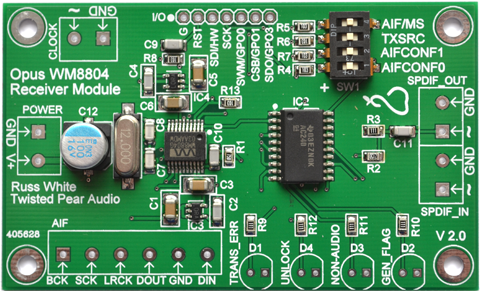
-------------------------------------------------------------
เปรียบเทียบสัญญาณ I2S = "BCK" , "LRCK" และ S/PDIF = "DATA"
Teralink X2 TE7022 : BCK - I2S

Twisted Pear Audio WM8804 : BCK - I2S

-------------------------------------------------------------
Teralink X2 TE7022 : LRCK - I2S

Twisted Pear Audio WM8804 : LRCK - I2S

-------------------------------------------------------------
Teralink X2 TE7022 : DATA - S/PDIF

Twisted Pear Audio WM8804 : DATA - S/PDIF

-------------------------------------------------------------
หน้าตาของ JITTER (ผีตัวหนึ่ง ของ สัญญาณดิจิตอล)
 Last edited by keang; 25 Apr 2011, 19:49:43.
Last edited by keang; 25 Apr 2011, 19:49:43.
Comment
-
เรียนช่างมารึเปล่าครับเนี่ยOriginally posted by flures View Postตามทฤษฏีได้ 4เท่าครับ
เนื่องจากนำ amp 2ชุด มาขยายสัญญาณชุดเดียวกัน Vout เป็น 2เท่า ของ amp ตัวเดียว
มาหา Power จะได้ 4เท่า
เช่น เดิม amp 20w ลำโพง 8โอม
จาก P=V^2/R
20=V^2/8
V=12.65
ทำ bridge, V เป็น 2เท่า คือ 25.3
เข้าสูตรเดิม P=25.3^2/8 = 80w
แต่ในทางปฏิบัติได้ไม่ถึงไม่เถียง เพราะ การสูญเสียต่าง ความไม่สมมาตรของสัญญาณ เพียงแต่ทฤษฏีเป็นไปได้ครับ
Comment
-
ของฝาก คุณfanderfree และ คนที่สนใจเรื่องRoom Acoustic
เครดิต > Paul Spencer : เวป Red Spade Audio
How does the bass of speakers combine in a room? > คลิก
What happens when you combine the bass response of two speakers? I'm referring to their real-world behaviour that you hear from your listening position, when all of their room-related peaks and dips are combined together?
We expect the bass level to be increased by 6 db. Do we actually get this much increase?
Do the peaks and dips average out? Or do they combine in a more complex way?
This chart shows two subs measured individually, with an average calculated response. This isn't the same as what you will measure if you measure them together. The response doesn't average out like this.
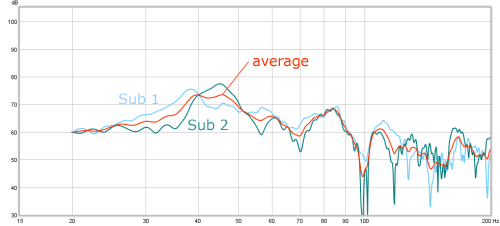
Peaks sum together. Dips don't subtract. Responses don't average peaks and dips. Where phase interference doesn't occur this will hold true and the combined response will be equal to or greater than the sum of all peaks.
Here you can see the measured response of two subs - left (green) and right (red) and the two combined (black).
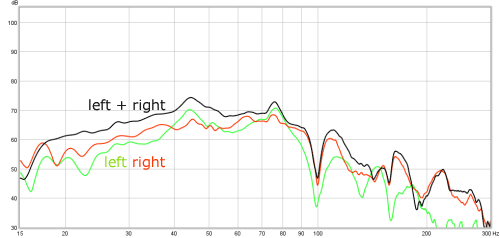
The shaded regions show where the left sub has a lower level (shaded green), or where it has a higher level (red). The combined response more closely matches that of the right sub where it is higher. The most obvious deviation is the peak at 44 Hz where the left sub has higher output. Below 25 Hz the behaviour changes and room gain appears to have some additional influence.
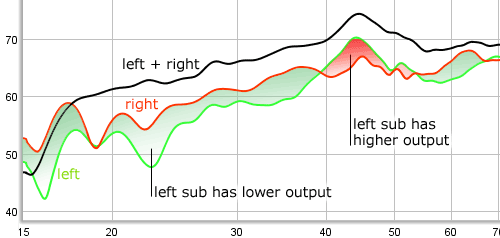
At the upper end of the modal range, we see some patterns more clearly. Here the combined response tracks that of the louder right sub even more closely. The dip at 100 hz remains because both subs have it, however the combined level is the lesser of the two. The dip around 140 Hz is eliminated completely because the flatness of the right sub dominates. The sharp dip at 160 Hz is also ignored as is the response of the left sub from 200 - 300 Hz where it is much lower in level.
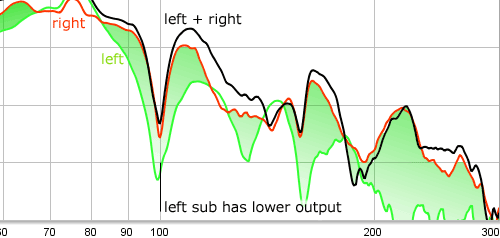
In general, we can conclude:
- dips are not subtractive - they can be removed by adding another bass source that doesn't have the same dip
- peaks sum together
- the combined response of two bass sources is generally not an average, but it is more like the combined maximum level of the two
This has some implications in bass integration. The one that is of interest is that dips can be removed by adding bass sources together. These dips are best removed in this way rather than trying to use EQ. Bass traps are generally ineffective here.
Here is another example:
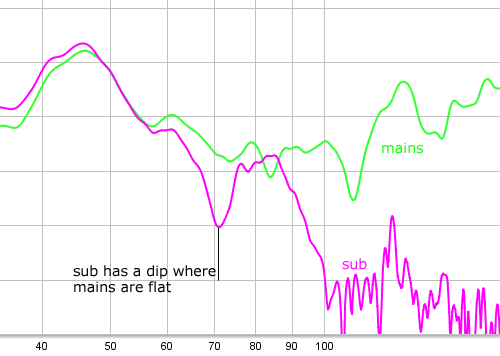
You can see the sub has a dip that the mains do not. The solution is to overlap the responses of both. So rather than crossing at 80 Hz, in this particular setup I ran the mains down to 60 Hz with a high pass at that point. The mains could in fact easily extend down to 23 Hz, however there was no need.
-------------------------------------------------------------
An afternoon with Adam Speakers > คลิก

Adam are one of not too many speaker manufacturers who make active speakers for home use. I paid a visit to the home of one owner to have a listen and help with taking some measurements. I had heard these speakers in this room before and this time they left a different impression.
The first time around, they had a forward and precise sound. Out of curiosity I had a look at the rear panel controls and noted that the treble had been turned up - that explained the forwardness of the presentation. This time they were quite a bit more mellow and the level had been reduced by 2db shy of flat, which turned out to be a nice balance.
Never heard of Adam speakers?
They make both home audio and studio speakers. The speaker in question here is the Tensor Delta. It has a 9" woofer combined with a Heil mid and tweeter. They are driven by built-in class D amps and a class AB amp for the tweeter. What you can't tell from the website is how well finished they are. The finish is pristine and the build quality exceptional.


You may notice some foam behind the speakers. I brought some along as temporary "bass trap reinforcements." You can see one of the existing bass traps in the corner on the left. We took some measurements with Fuzz Measure and in the waterfalls we could see some improvement with the four added foam scrap traps in the corners. They are not nearly big enough or the right material to fully trap a room, but they were enough for us to see a difference in the measurements.

We took some gated measurements at 1m in less than ideal conditions with boundaries a little too close. Ideally one would elevate the speaker to a height of 1.8m outdoors and gate out the first reflection from the floor. We didn't quite have the space or time so we did a "cheat measurement" using foam to damp the nearest two reflections as shown. This allows us to measure to lower frequencies. We took a series of measurements, including nearfield, farfield, and gated @ 1m.
The nearfield plots revealed a very smooth and flat response.

This isn't the normal way to measure speakers, but it is more common for a subwoofer. I took a nearfield measurement of the woofer, but the other drivers were measured that way out of curiosity.
One thing that was demonstrated was the way in which having less bass can make a speaker "room friendly." For a stand mount, these are certainly bass capable. While the room has not been tamed with extensive EQ or bass traps, the owner had turned back the bass a little to compensate. On most tracks this resulted in the bass sounding well under control.Last edited by keang; 25 Apr 2011, 22:10:32.
Comment




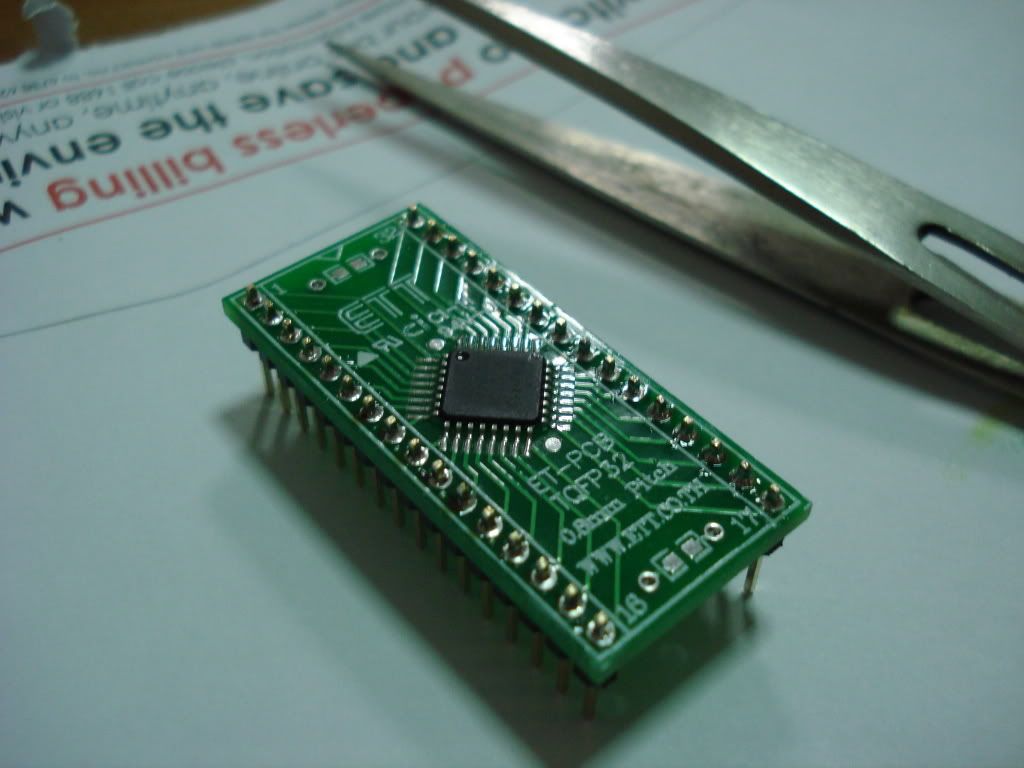
Comment